I've enjoyed the section of A111 dedicated to examining the use of portraiture to create and promote 'reputations' for Elizabeth I - both during her lifetime and, in the figure below, following her death in 1603.
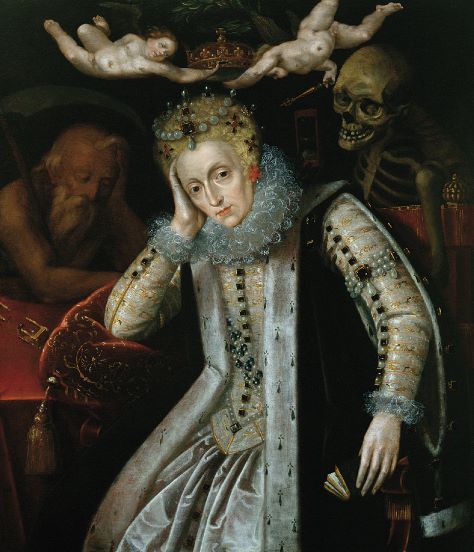
Unknown artist (English school), Queen Elizabeth I in Old Age or Allegorical Portrait of Queen Elizabeth I, c.1610, oil on panel. Corsham Court, Wiltshire. Photo: © Bridgeman Images.
Beginning to learn to decode courtly art; the meaning of colours, clothes, the 'language' of flowers, a whole string of props from sieve's to stoats, certainly adds to the enjoyment of what otherwise are perhaps rather dull (certainly static and mannered) images. It has also been interesting to discover the way in which the written and visual arts combined in this tiny world of elite courtiers. Exploring the 'Allegorical Portrait', and the images of 'Death' and 'Time' that bookend Elizabeth, a number of authors point to links to the works of the Renaissance poet Petrarch - and in particular his 'Triumphs', written between 1351-1374.1,2,3.
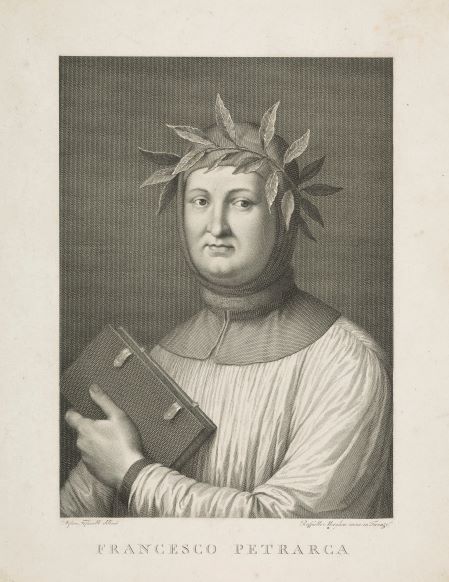
Francesco Petrarca, 1304 - 1374. (Petrarch) Florentine poet. Stefano Tofanelli & Raphael Morghen. Out of Copyright, National Galleries of Scotland
In this collection of six poems, Petrarch describes a sequence of linked allegorical battles, victories and triumphal parades, starting with that of Love, Love is then conquered by Chastity (personified by Petrarch's muse, Laura), Chastity is defeated by Death, Death by Fame, Fame by Time and Time by Eternity.
'Laura' was one persona through which Elizabeth could be presented as having 'acceptable' female power (along with Diana, Deborah, Judith etc.). In this instance chaste but triumphant, without having to engage in actual physical conflict. There are visual links to the 'Triumph of Chastity' in particular in a number of portraits of Elizabeth, the 'Sieve' portraits link her with the vestal Tuccia who miraculously proves her chasteness in holding water in a sieve. Tuccia features in the 'Triumph of Chastity', as does Dido, another character in at least one sieve portrait. There are quotes from the Petrarch poems in some portraits as well.
The first lines of Petrarch's 'Triumph of Fame' certainly appear to capture the look of Elizabeth in the 'Allegorical Portrait'.
“When cruel Death his paly ensign spread
Over that face, which oft in triumph led
My subject thoughts; and beauty's sovereign light,
Retiring, left the world immersed in night”
‘The Triumph of Fame’(Petrarch)
But Roy Strong and others see links in this posthumous portrait through all of the sequence of Triumphs,1,2,3 highlighting the presence of a laurel wreath (the mark of a Roman Triumph) at the very apex of the picture and the inclusion of both 'Time' and 'Death'. The general view seems to be that the portrait was created at a point in James I's reign, possibly in the 1620's when he was losing favour in some quarters whilst attempting to establish a marriage for his son Charles with the daughter of (Catholic) Philip III of Spain. Making this then a piece of Protestant 'protest', showing the old Queen in eternal triumph, having backed the 'right side' in the religious divide.However, not all authors see the portrait in this light. The collection of essays 'Dissing Elizabeth' brings together a number of perspectives on dissent from the vision of 'Good Queen Bess' which was expressed in a variety of ways. This includes through visual images and the book's editor, Julia Walker, considers the Allegorical portrait in her chapter on Elizabeth's reputation after her death, 'Bones of Contention: Posthumous Images of Elizabeth and Stuart Politics'4.
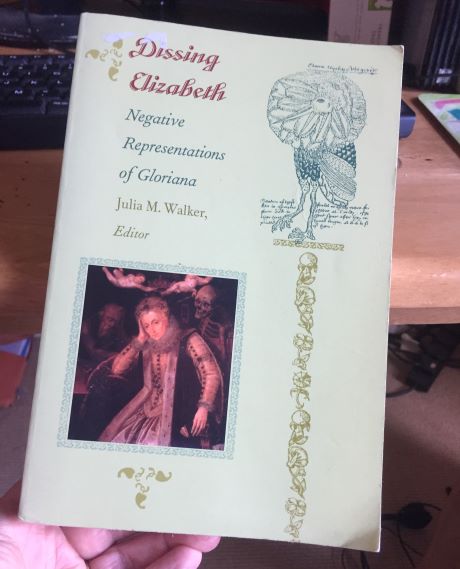
J. M. Walker Ed. (1998). Dissing Elizabeth: negative representations of Gloriana. Duke University Press.
Walker views the portrait as a mocking parody of the 'Armada Portrait' which we studied in A111. She highlights the mirrored seated postures, the same plush red imperial furnishings and contrasts the over the shoulders backdrop of Armada victory with an Elizabeth wasted by the ravages of the now overlooking 'Time' and 'Death'. The Imperial crown that took pride of place is now being whisked away by (left-handed) cherubs, along with any vestiges of Elizabeth's power...
'... it seems more than a possibility that Elizabeth with Time and Death was commissioned not merely as a parody of the queen at her most powerful, but as a dismissal of Spain as the natural enemy of England and English monarchs, substituting instead the more universal Time and Death.'
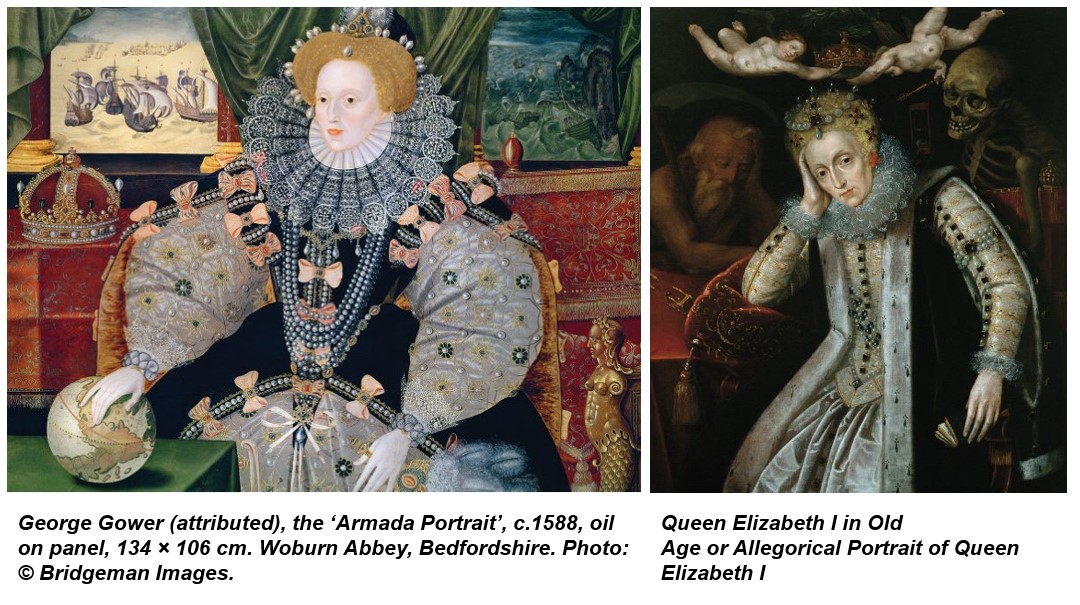
Walker considers that the portrait's patrician owner must have fallen very much in the King's camp at the time of the 'Spanish Match' controversy.
I found Walker's chapter fascinating, the contested 'Bones' she refers to in her title are those of Elizabeth herself which were relocated by James I from a prime site under the main altar of the Henry VII chapel in Westminster Abbey to shared accommodation with her older sister Mary, whilst Mary Queen of Scots (James's mother) getting a massive new monument.
However, it was interesting that Walker makes no reference at all in her work to the alternative (and earlier) academic ideas that the allegorical figures might have been drawn from Petrarch.

There is one difference between the image we looked at in A111 and the one that Walker shows in her figures (and in the cover art for the book) - the portrait is slightly cropped at the top, just sufficiently that the laurel wreath is invisible.
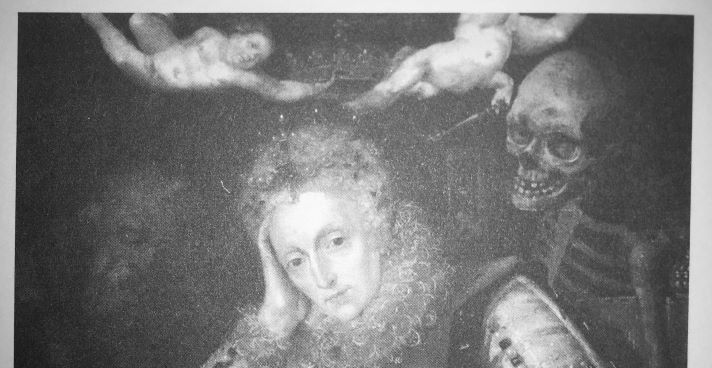
So I'm left wondering, did access to only a cropped image influence Walker's interpretation of the portrait, or was the image cropped so as to better fit the interpretation? Or.... (and no doubt most likely) was the cropping entirely coincidental, something that happened when the book was being setup for printing for example?
No answers - but perhaps that in itself is an excellent way to mark one of the key learning points from the Elizabeth I chapter, that interpretations between historians vary and will continue to vary as they try and evaluate the fragmentary and complex primary evidence.
References
- Campbell, H. (2007) ‘“And in their midst a sun”: Petrarch’s Triumphs and the Elizabethan icon’, in A. Connolly and L. Hopkins (eds) Goddesses and queens: the iconography of Elizabeth I. Manchester, UK: Manchester University Press, pp. 83–100.
- Peterson, K.L. (2018) ‘Picturing Elizabeth I’s Triumph of Melancholy’, English literary renaissance, 48(1), pp. 1–40. Available at: https://doi.org/10.1086/696110.
- Strong, R. (1987) Gloriana : the portraits of Queen Elizabeth I. London: Pimlico.
- Walker, J. M. (1998). Bones of Contention: Posthumous Images of Elizabeth and Stuart Politics. In J. M. Walker (Ed.), Dissing Elizabeth: negative representations of Gloriana (pp. 252–276). Duke University Press.
